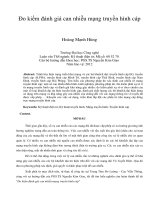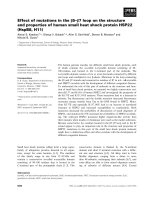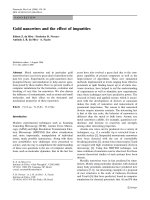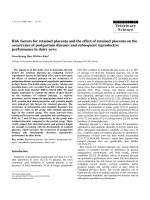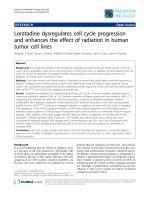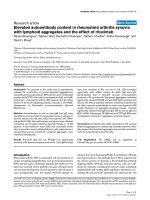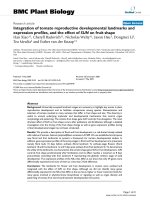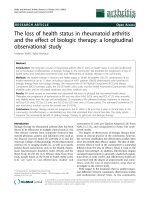Appraisal burning characteristic and analysis effect of cavity in scramjet combustion chamber
Bạn đang xem bản rút gọn của tài liệu. Xem và tải ngay bản đầy đủ của tài liệu tại đây (830.98 KB, 8 trang )
JST: Engineering and Technology for Sustainable Development
Volume 32, Issue 2, April 2022, 024-031
Appraisal Burning Characteristic and Analysis Effect of Cavity
in Scramjet Combustion Chamber
Van-Minh LE, Cong-Truong DINH*, Quoc-Khanh PHAM, Duc-Huy TA,
Quang-Sang VO, Hong-Quan LUU, The-Mich NGUYEN, Anh-Tuan NGUYEN
School of Mechanical Engineering, Hanoi University of Science and Technology, Hanoi, Vietnam
*
Email:
Abstract
The combustion chamber clearly plays an critical role in generating thrust force so the aircraft can move
forward. A scramjet (supersonic combustion ramjet) is a variant of a ramjet airbreathing jet engine in which
combustion takes place in supersonic airflow. Researchers are constantly working to improve the efficiency of
ultrasonic combustion furnaces by various methods such as: optimize fuel injectors, optimize combustion
chamber geometry design, create hole cavity. In this research, the characteristic of supersonic airflow were
investigated, and a comparison between the standard chamber and advanced chamber was made to
determine the effects of a circular hole (cavity) on pressure and velocity of the fuel mixture through the
scramjet. Two dimensional Reynolds-Averaged Navier-Stokes governing(RANS) equations with k−ε
turbulence model and finite rate/eddy dissipation chemistry model have been considered for modelling
chemical reacting flows. From the comparison of numerical results, it is found that the development of
recirculation regions and additional shock waves from the edge of cavity flame holder is increased and
achieved stabilized combustion. From this research analysis, the performance of the scramjet engine with
cavity is significantly improved as compared to the design without cavity.
Keywords: Combustion chamber, scamjet, cavity, RANS analysis, shock wave, thrust.
1. Introduction *
The scramjet engine is superior to today's
aviation vehicles. The scramjet engine is designed to
avoid high drag and low combustion efficiency at high
Mach numbers by keeping the supersonic flow
negative throughout the engine especially in the
combustion chamber. Avoiding strong impact waves
like the Ramjet has significantly reduced engine drag.
The reaction time of only a few milliseconds and the
limitation of the combustion's length are the two main
issues that hinder the engine’s efficiency. The way that
the stored fuel is injected into the compressed air also
plays a pivotal role. Therefore, researchers are trying
to find the optimal locations for fuel injection to
achieve higher performance at supersonic speeds.
Combustor geometry has a huge effect on
combustion process. Araújo et al. [1] has researched
the characteristics of a two-dimensional combustor at
transonic velocity (Mach 5-10) with the fuel is the
mixture of air and products of burning hydrocarbon
CxHy. The two-dimensional model in the current work
is inspired by this paper, but with a simplified
condition – burning process is just between H2 and O2,
Mach numbers inlet is 2.0. Kummitha and Pandey [2]
experimented with the same two-dimensional model
but with wavy wall strut. They found that the changes
in strut wall changed the mixing process behavior and
increased the combustion efficiency significantly.
Choubey and Pandey [3], and Kummitha et al. [4] used
different strut designs, struts numbers and angles of
attack, in the combustor and found that the modified
model increased combustion efficiency and decreased
the ignition delay. Another research on the cavity
inside combustion chamber was conducted by BenYakar and Hanson [5] but with different dimensions –
3 mm depth, as a result, the cavity has a certain effect
in keeping and mixing the fuel in the combustion
chamber.
Huang and Zhang [6] studied two different
combustion models i.e., ultrasonic and subsonic using
numerical simulation. A scramjet test engine of the
German Aerospace Center (DLR) was selected with a
parallel fuel injection system. The kinetic chemistry in
the scramjet combustion chamber under dual-mode
was explained using mode transition by Shen et al. [7]
and Abu-Farah et al. [8], Who explained hydrogen’s
combustion behaviors with struts are improved at fuel
injectors. Data investigation was performed by
selecting the LES model to find out the effect of the
chemokinetic mechanism between hydrogen and air by
Liu et al. [9]. The non-burn behavior in a two-
ISSN 2734-9381
/>Received: February 14, 2022; accepted: February 27, 2022
24
JST: Engineering and Technology for Sustainable Development
Volume 32, Issue 2, April 2022, 024-031
dimensional model was investigated by Gruber et al.
[10]. Non-combustion mode is a process where the
fuel mixture is kept cold to evaluate the behavior of the
fuel flow in the combustion zone caused by changes in
the geometry and mixing process.
hypersonic speeds (over Mach 5), but the combustion
process in combustion chamber happens in supersonic
mode. A typical scramjet engine has four main
components: inlet, isolator, combustor, and ultrasonic
exhaust (nozzle) as shown in Fig. 1 [7].
As shown in the literature review above, only this
system or the transverse injection system has been
studied by other researchers. Parallel fuel injection or
bulkhead fuel transfer systems have not yet been
extensively studied for combustion chamber
efficiency. On the basis of previous research results as
well as experimental results for scramjet engine
combustion chambers, the content of this paper is to
propose a reliable numerical simulation model and
method. CFD simulation with k-ε model and simple
H2-O2 combustion is applied to achieve faster and
more accurate results. In addition, an assessment of the
influence of the cavity design on the efficiency of the
furnace is carried out, thereby drawing conclusions
about the more optimal design.
The designed model used in this paper is
presented in Fig. 2. The total length of the combustion
chamber is 340 mm and height at the inlet is 50 mm
and at the outlet 62 mm. The method of fuel injection
is parallel with the help of a symmetrical wedgeshaped strut. The symmetrical wedge strut is 6 mm
high and 32 mm long containing the injectors that
guide the combustion fuel. The wedge tip is positioned
77 mm from the inlet. The diameter of each fuel
injector is 1 mm with 15 consecutive holes (with a
constant distance between the holes of 2.4 mm).
2. Numerical Analysis
2.1. Design Description
In this work, the research object is a scramjet
engine. It is a kind of engine designed to operate at
In the work, we consider the injector at eighth
hole with the cross section between the nozzles. The
effect of circular cavity on combustion performance is
also included as shown in Fig. 3. The hole has
the radius of 15mm, and is put after the
wedge strut, the distance between the hole and inlet is
x (80 mm
Fig. 1. Scramjet's components
Fig. 3. Model with cavity
Fig. 2. Combustor's parameters of scramjet engine
25
JST: Engineering and Technology for Sustainable Development
Volume 32, Issue 2, April 2022, 024-031
2.2. Numerical Method
The computational model was built using
ANSYS Fluent 19.1 [11]. Details of the selection
models are presented in the following sections. The
Reynolds-averaged Navier Stokes (RANS) equations
were solved with k-ε turbulence model. The Reynolds
Average Navier Stokes Equation (RANS) model is
useful for capturing behavioral variables of the flow.
The RANS average method is suitable for 2D
simulations such as considering the gas flow through
the fuel injectors and the combustion in the
combustion chamber under consideration.
Combustion modelling is used to capture the
potential interactions between fuel and air. The feature
transport
model
with
Turbulence-Chemistry
Interaction used as Eddy-Dissipation was chosen to
explore the properties of the current field. Fuel mixing
efficiency and combustion efficiency are the two most
important characteristics to evaluate the efficiency of
the scramjet combustion chamber. Mixing efficiency
is the ratio of the density of fuel injected in the
combustible area A to the total fuel injected. The
efficiency of a combustion chamber with unreactive
(non-combustible) flow with the addition of fuel mass
is characterized by the mixing efficiency (𝜂𝜂𝑚𝑚 ), defined
by the equation:
𝜂𝜂𝑚𝑚 =
.
∫𝐴𝐴 𝛼𝛼.𝜌𝜌𝑔𝑔𝑔𝑔𝑔𝑔 .𝑌𝑌𝐻𝐻2 𝑢𝑢𝑢𝑢𝑢𝑢
𝑚𝑚𝐻𝐻̇ 2
1, 𝜙𝜙 < 1
, with 𝛼𝛼 = � 1
, 𝜙𝜙 ≥ 1
∫�𝐴𝐴(𝑥𝑥)�𝜌𝜌𝑔𝑔𝑔𝑔𝑔𝑔 .𝑌𝑌𝐻𝐻2 𝑢𝑢𝑢𝑢𝑢𝑢
𝑚𝑚̇𝐻𝐻
2,𝑖𝑖𝑖𝑖𝑖𝑖
Table 1. Boundary conditions
Indicator
Air inlet
Fuel
Mach number
2.0
1.0
Static pressure (Pa)
100 000
100 000
Static temperature (K)
340
250
Density (kg/m3)
0.9734944
0.09698617
Velocity (m/s)
756.1424
1203.324
Table 2. Proportion between air and fuel inlet
(1)
Mass ratio
O2
H2 O
N2
H2
Air
0,232
0,032
0,736
0
Fuel
0
0
0
1
𝜙𝜙
in which ρgas is the density of the air; YH₂ is mass ratio
of hydrogen with air ( 𝑌𝑌𝐻𝐻2 = 𝜌𝜌𝐻𝐻2 /𝜌𝜌𝑔𝑔𝑔𝑔𝑔𝑔 ) ; u is
the normal velocity; A is the cross-sectional
area and 𝜙𝜙 is the equivalence ratio, defined as
𝜙𝜙 = 𝑀𝑀𝑂𝑂2 𝑌𝑌𝐻𝐻2 /2𝑀𝑀𝐻𝐻2 𝑌𝑌𝑂𝑂2 with M is the molar mass and
Y is the mass of the gas; 𝑚𝑚𝐻𝐻̇ 2 is the flow rate of the
injected hydrogen. A good fuel mixing efficiency will
give good combustion efficiency. Combustion
efficiency can be defined as the ratio of the amount of
hydrogen burned to the total gas intake of hydrogen.
Combustion is a fast chemical reaction with a high
degree of turbulence. The mathematical equation of
fire can be written as follows:
𝜂𝜂𝑐𝑐𝑐𝑐𝑐𝑐𝑐𝑐 (𝑥𝑥) = 1 −
detail areas, so using a structural grid provides easier
grid control, shorten the computing time while still
providing accuracy as shown in Fig. 4. The detail of
boundary conditions are presented in Tables 1 and 2
below.
=1−
𝑚𝑚̇𝐻𝐻2,𝑥𝑥
𝑚𝑚̇𝐻𝐻2,𝑖𝑖𝑖𝑖𝑖𝑖
(2)
in which 𝑚𝑚̇𝐻𝐻2,𝑥𝑥 is the mass flow of hydrogen at a given
cross-sectional position x; 𝑚𝑚̇𝐻𝐻2,𝑖𝑖𝑖𝑖𝑖𝑖 is the total mass
flow of injected hydrogen and 𝜂𝜂𝑐𝑐𝑐𝑐𝑐𝑐𝑐𝑐 is combustion
efficiency.
The geometry and the computational grid were
generated using Design Modeler and ICEM-CFD,
respectively. A structural grid was used with
quadrangular elements, refined at the edges, cutting
points and fire zones to clearly capture the flow
phenomenon. The configuration of the wedge is
isosceles triangle, so there are not many asymmetrical
Fig. 4. Mesh of Model
3. Result and Discussion
3.1 Grid Independence Test and Validation Results
Performing meshing and calculating the pressure
on the lower wall and the middle wall as shown in
Fig. 5, it was found that from about 110,000 mesh, the
pressure value starts to stabilize and at more than
162,000 mesh, the optimal value is reached. In fact, the
number of nodes in the article is 162,486 grids,
checking the effect of mesh number on pressure’s
stability is acceptable.
First, the investigation was made with cold and
not-burnt fuel (hydrogen) to observe the shock waves
and evaluate the density, pressure, Mach number and
so on before burning fuel in the combustion chamber.
The shock waves generated at the tip of the fuel
injector are complex. Extended fan-shaped regions
behind the symmetrical wedge are followed by oblique
26
JST: Engineering and Technology for Sustainable Development
Volume 32, Issue 2, April 2022, 024-031
collision waves and reflected waves with
corresponding deflection amplitudes. The results from
simulations are close with experiments about the shock
waves’s position, structure, and profile (Fig. 6). In
Fig. 6, at x = 142 mm and x = 227 mm, there is a
difference between the reflected wave at subsonic
frequencies and the visible supersonic fuel flow.
Between 137 mm < x < 142 mm the complex
interaction of the two shock waves generated at the tip
of the wedge and reflected at the channels top and
bottom walls with the hydrogen jet is resolved in
detail. Because of the one-sided divergent channel, the
upper shock wave hits the subsonic hydrogen jet a bit
further downstream than the lower shock wave
yielding a non- symmetric flow field. The lower shock
wave generates a strong pressure gradient in the
hydrogen jet leading to a slight expansion of the jet.
On the lower side of the hydrogen jet there is only a
compression wave but not a shock wave. In the
supersonic flow region at x = 227 mm the shock waves
are not reflected at the jet, rather they are deflected by
crossing the jet. There are two shock waves in the
shadow picture originating from the base of the wedge.
These shock waves are generated by some
irregularities on the wedge surface. Clearly, these
shock waves and the resulting flow structures are not
caught by the simulation.
In the experiment, researchers used Laser
Doppler Velocimetry (LDV) for velocity measurement
[12]. Fig. 8 compares simulation results and
experimental results of axial velocity at 4 sections:
x = 120 mm, x = 167 mm, x = 199 mm and
x = 275 mm. Peak velocity at four different x values in
simulation are 805 m/s, 831 m/s, 771 m/s and 751 m/s
respectively. These two results above are quite
likeness and trustable.
2,5
165000
200000
Pressure (Pa *105)
Maximum pressure (Pa)
205000
Although the overall agreement between the
experiment and the calculation (Fig. 7) is good, the
pressure peaks at x = 130 mm at the lower channel wall
and at x = 110 mm in the middle of the channel are
missing in the computation. The reasons for the
discrepancy could be the influence of threedimensional effects. In the experiment the hydrogen is
injected through 15 holes resulting in a truly threedimensional flow field. Furthermore, the pressure
measurements were taken near the side walls of the
channel where corner and boundary layer effects are
present. Another possible explanation are interactions
of wall boundary layers with the shock waves. These
effects are not taken into account here since slip
boundary conditions have been applied.
160000
195000
155000
190000
150000
185000
Lower wall (y=0)
Middle wall (y=25mm)
180000
175000
20
80
130
162
210
260
Simulation
2
Experiment
1,5
1
0,5
0
145000
90
130
170
210
250
290
330
x (mm)
140000
a) Bottom wall (y=0mm)
Grid nodes number (x103)
2
Fig. 5. Grid dependency test.
Simulation
Experiment
Pressure (Pa *105)
1,8
Selected point
1,6
1,4
1,2
1
0,8
0,6
0,4
0,2
0
90
130
170
210
x (mm)
250
290
b) Middle (y=25mm)
Fig. 7. Pressure distribution
Fig. 6. Validation results: Experiment result – shadow
picture (top); Numerical pressure (bottom)
27
330
JST: Engineering and Technology for Sustainable Development
Volume 32, Issue 2, April 2022, 024-031
50
50
Simulation
Experiment
40
45
Simulation
40
Experiment
30
y (mm)
y (mm)
35
20
30
25
20
15
10
10
5
0
200
400
600
800
0
1000
Velocity(m/s)
200
400
600
800
1000
Velocity(m/s)
a) Axial velocity (x=120 mm)
c) Axial velocity (x=199 mm)
50
50
Simulation
45
Simulation
40
Experiment
Experiment
40
30
y (mm)
y (mm)
35
25
20
30
20
15
10
10
5
0
200
400
600
800
0
1000
200
400
600
800
Velocity(m/s)
Velocity(m/s)
b) Axial velocity (x=167 mm)
d) Axial velocity (x=275 mm)
Fig. 8. Axial velocity
In the following section, the numerical results’
validity will be examined when fuel mixture was set to
burn. Hydrogen fuel is injected and burned at M = 1
and ambient temperature. Both velocity and
temperature of streamline are included below. The
overall structure and the difference between simulation
calculation and experimental results can be seen in
Fig. 9 with flow density and pressure calculation.
Compared to the shadow picture the calculated
combustion zone is too broad at x = 145 mm with a
stronger narrowing further downstream. Besides the
acceleration by thermal expansion in the flame, there
is an acceleration by the constriction of the subsonic
jet for x >145 mm. The stronger contraction in the
computation results in a larger speed than
experimentally observed.
Fig. 10 shows axial velocity at cross section
x = 120 mm and x = 167 mm. Peak velocity at both
cross sections is match with experiment results, which
are 700 m/s at x = 120mm and 674 m/s at x = 167 mm.
Fig. 11 plots temperature at cross section x = 120 mm,
x = 167 mm and x = 275 mm in simulation and
experiment. Maximum temperature approach 2139K
at x = 120 mm, 2335K at x = 167 mm and 2139K at
x = 275 mm around middle y value.
There are some overcoming at peak value of
temperature in experiment results compared with
experiment results. These deviations occur because of
the simple combustion model (one-order chemical
equation for one-order reaction).
28
JST: Engineering and Technology for Sustainable Development
Volume 32, Issue 2, April 2022, 024-031
50
Simulation
45
Experiment
y (mm)
40
35
30
25
20
15
10
5
45
Simulation
Experiment
y (mm)
y (mm)
35
25
15
5
0
200
400
600
Velocity (m/s)
800
1000
50
45
40
35
30
25
20
15
10
5
Experiment
0
1000
2000
3000
b) Temperature at cross section x=167 mm
Simulation
45
Simulation
Experiment
40
Experiment
35
3000
Simulation
50
45
2000
Temperature (K)
a) x = 120 mm
y (mm)
y (mm)
35
25
30
25
20
15
15
5
0
Temperature (K)
a) Temperature at cross section x=120 mm
Fig. 9. Comparison: Experiment result – shadow
picture (top); Numerical pressure (bottom)
10
5
0
200
400
600
800
Velocity (m/s)
at
1000
Temperature (K)
2000
c) Temperature at cross section x=275 mm
b) x=167 mm
Fig. 10. Axial velocity
(a) x=120mm; (b) x=167mm
0
cross
section:
The model used in this case is simple but
provides quite precise results and well-known in
simulation community. It adapts well in different
conditions in simulation models, too. The simulation
results confirm this. Though there are some missing at
some value, in general, the trend and the coincident
between simulation and experiment results is superb
and reliable, suitable in investigating further research.
Fig. 11. Temperature comparison at cross section:
(a) x=120mm; (b) x=167mm; (c) x=275mm
3.2. Effect of Circular Cavity on Combustion
Performance
In the following discussion, a round hole cavity
was drilled behind the fuel injector, for the purpose of
changing the impact wave interaction, improving the
fuel mixing efficiency. Results archived in simulation
are compared with data of experiment with standard
model.
29
JST: Engineering and Technology for Sustainable Development
Volume 32, Issue 2, April 2022, 024-031
100
η%
80
60
40
Model with hole
Standard model
Experiment
20
0
60
100
140
180
x (mm)
a) Mixing efficiency
220
260
Fig. 13. Pressure distribution: (a) without hole; (b)
with hole
80
η (%)
60
40
Experiment
20
Model with hole
Standard model
0
75
175
275
x (mm)
b) Combustion efficiency
375
Fig. 12. Comparison mixing and combustion
efficiency in different models: a) Mixing efficiency;
(b) Combustion efficiency
Fig. 12 shows the mixing and combustion
efficiency of jet burners with and without a circular
hole. Data of simulation with standard model and
experiment are very coincident, which proves the
precision of simulation and experiment model. All
peak values are significantly increased after adding the
hole in mixing and combustion efficiencies, about
8.5% and 7,2% respectively than experiment
combustion.
Fig. 13 and 14 compare pressure and density
distribution in simulation in 2 combustion chamber
models (with or without cavity hole). If combustion
chamber has cavity hole, several shockwaves are
added under the mainstream, after the hole, while
streamline above mainstream seem unchanged. The
model with the round hole has pushed the mixing area
closer to the injector, the wave density and distribution
of pressure are thicker.
Fig. 14. Density distribution: (a) without hole; (b) with
hole
4. Conclusion
In this work, numerical simulations of the
injection of hydrogen fuel into a supersonic airstream
are performed with and without the combustion
progress. The simulation results are similar incredibly
to the experimental measurements. The numerical
approach is capable of computing chaotic diffuse
flames in complex geometries, has good advantages,
and gives reliable results. The results once again prove
the validation and the variety in choosing boundary
conditions of simulation model in this work. On the
other hand, a rounded cavity in Scramjet combustion
chamber has more mixing zones, shock waves, and
vortex zones and all of this has improved the timing
and mixing of the fuel with the air. The stability and
efficiency are enhanced as well. From all figures and
graphs, it is observed that pressure and temperature in
the vicinity of the circular cavity and the boundary
layer separation are increased.
30
JST: Engineering and Technology for Sustainable Development
Volume 32, Issue 2, April 2022, 024-031
From all the results and evaluations, it can be
concluded that the performance of the scramjet
combustion chamber with the circular cavity has been
increased compared to the standard scramjet model
without the cavity.
Further work should be focused to improve the
physical model: three-dimensional effects and
different fire models. The effect of cavity addition
such as aerodynamic efficiency, additional mass effect
or material structure analysis will be investigated in the
future as well.
AIAA/ASME/SAE/ASEE
Joint
Propulsion
Conference and Exhibit, American Institute of
Aeronautics and Astronautics Inc, AIAA, 1998,
/>[6]
Z. Huang H. Zhang, Numerical investigations of mixed
supersonic and subsonic combustion modes in a model
combustor, International Journal of Hydrogen Energy,
vol. 45, no. 1, pp. 1045–1060, 2020
/>
[7]
W. Shen, Y. Huang, Y. You, and L. Yi, Characteristics
of reaction zone in a dual-mode scramjet combustor
during mode transitions, Aerospace Science and
Technology, vol. 99, 2020
/>
[8]
L. Abu-Farah, O. J. Haidn, and H. P. Kau, Numerical
simulations of single and multi-staged injection of H2
in a supersonic scramjet combustor, Propulsion and
Power Research, vol. 3, no. 4, pp. 175–186, 2014,
/>
[9]
B. Liu, G. Q. He, F. Qin, J. An, S. Wang, and L. Shi,
Investigation of influence of detailed chemical kinetics
mechanisms for hydrogen on supersonic combustion
using large eddy simulation, International Journal of
Hydrogen Energy, vol. 44, no. 10, pp. 5007–5019,
2019
/>
Acknowledgment
This study is funded by Hanoi University of
Science and Technology (HUST) under grant numbers
T2021-TT-009 and T2021-PC-039.
References
[1]
P. P. B. Araújo, M. V. S. Pereira, G. S. Marinho, J. F.
A. Martos, and P. G. P. Toro, Optimization of scramjet
inlet based on temperature and Mach number of
supersonic combustion, Aerospace Science and
Technology, vol. 116, 2021
/>
[2]
O. R. Kummitha and K. M. Pandey, Hydrogen fueled
scramjet combustor with a wavy-wall double strut fuel
injector, Fuel, 304, 2021
/>
[3]
G. Choubey and K. M. Pandey, Effect of variation of
angle of attack on the performance of two-strut
scramjet combustor, International Journal of Hydrogen
Energy, vol. 41, no. 26, pp. 11455–11470, 2016,
/>
[4]
O. R. Kummitha, K. M. Pandey, and R. Gupta,
Numerical analysis of hydrogen fueled scramjet
combustor with innovative designs of strut injector,
International Journal of Hydrogen Energy, vol. 45, no.
25, pp. 13659–13671, 2020
/>
[5]
A. Ben-Yakar and R. K. Hanson, Cavity flameholders
for ignition and flame stabilization in scramjets:
Review and experimental study, In 34th
[10] M. R. Gruber, R. A. Baurle, T. Mathur, and K. Y.
Hsu, Fundamental studies of cavity-based flameholder
concepts for supersonic combustors, Journal of
Propulsion and Power, vol. 17, no. 1, pp. 146–153,
2001
/>[11] ANSYS Fluent-19.1, 2018, ANSYS Inc.
[12] W. Waidmann, F. Alff, U. Brummund, M. Böhm, W.
Clauss, and M. Oschwald, Experimental investigation
of the combustion process in a supersonic combustion
ramjet (SCRAMJET) Combustion Chamber, in:
DGLR-Jahrestagung 1994; 04. - 07.10.1994; Erlangen.
31

